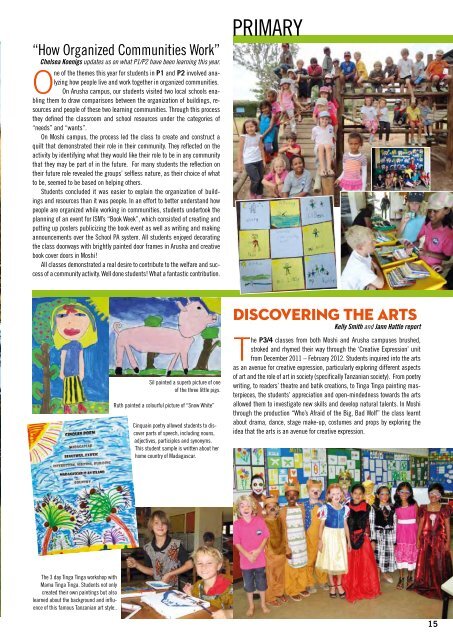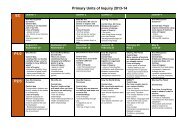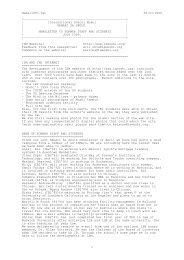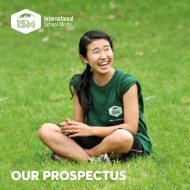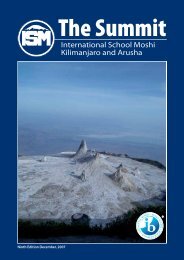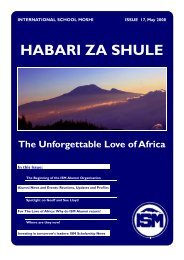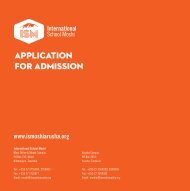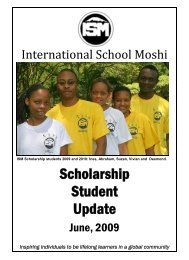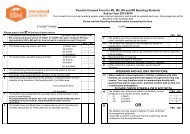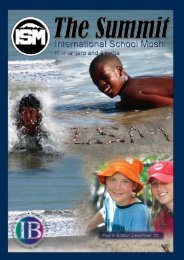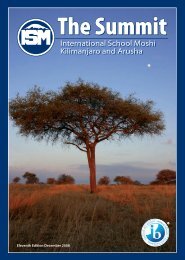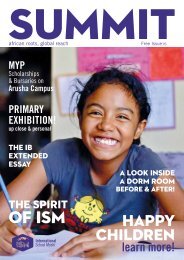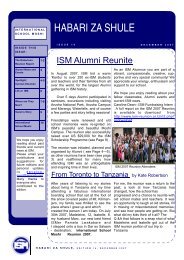June 2012 (5Mb) - International School Moshi
June 2012 (5Mb) - International School Moshi
June 2012 (5Mb) - International School Moshi
Create successful ePaper yourself
Turn your PDF publications into a flip-book with our unique Google optimized e-Paper software.
“How Organized Communities Work”<br />
Chelsea Koenigs updates us on what P1/P2 have been learning this year.<br />
One of the themes this year for students in P1 and P2 involved analyzing<br />
how people live and work together in organized communities.<br />
On Arusha campus, our students visited two local schools enabling<br />
them to draw comparisons between the organization of buildings, resources<br />
and people of these two learning communities. Through this process<br />
they defined the classroom and school resources under the categories of<br />
“needs” and “wants”.<br />
On <strong>Moshi</strong> campus, the process led the class to create and construct a<br />
quilt that demonstrated their role in their community. They reflected on the<br />
activity by identifying what they would like their role to be in any community<br />
that they may be part of in the future. For many students the reflection on<br />
their future role revealed the groups’ selfless nature, as their choice of what<br />
to be, seemed to be based on helping others.<br />
Students concluded it was easier to explain the organization of buildings<br />
and resources than it was people. In an effort to better understand how<br />
people are organized while working in communities, students undertook the<br />
planning of an event for ISM’s “Book Week”, which consisted of creating and<br />
putting up posters publicizing the book event as well as writing and making<br />
announcements over the <strong>School</strong> PA system. All students enjoyed decorating<br />
the class doorways with brightly painted door frames in Arusha and creative<br />
book cover doors in <strong>Moshi</strong>!<br />
All classes demonstrated a real desire to contribute to the welfare and success<br />
of a community activity. Well done students! What a fantastic contribution.<br />
PRIMARY<br />
DisCOvering the arts<br />
Kelly Smith and Jann Hattle report<br />
Sil painted a superb picture of one<br />
of the three little pigs.<br />
Ruth painted a colourful picture of “Snow White”<br />
Cinquain poetry allowed students to discover<br />
parts of speech, including nouns,<br />
adjectives, participles and synonyms.<br />
This student sample is written about her<br />
home country of Madagascar.<br />
The P3/4 classes from both <strong>Moshi</strong> and Arusha campuses brushed,<br />
stroked and rhymed their way through the ‘Creative Expression’ unit<br />
from December 2011 – February <strong>2012</strong>. Students inquired into the arts<br />
as an avenue for creative expression, particularly exploring different aspects<br />
of art and the role of art in society (specifically Tanzanian society). From poetry<br />
writing, to readers’ theatre and batik creations, to Tinga Tinga painting masterpieces,<br />
the students’ appreciation and open-mindedness towards the arts<br />
allowed them to investigate new skills and develop natural talents. In <strong>Moshi</strong><br />
through the production “Who’s Afraid of the Big, Bad Wolf” the class learnt<br />
about drama, dance, stage make-up, costumes and props by exploring the<br />
idea that the arts is an avenue for creative expression.<br />
The 3 day Tinga Tinga workshop with<br />
Mama Tinga Tinga. Students not only<br />
created their own paintings but also<br />
learned about the background and influence<br />
of this famous Tanzanian art style..<br />
15


